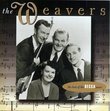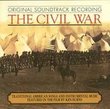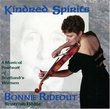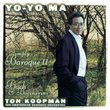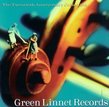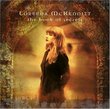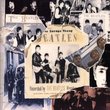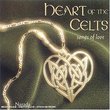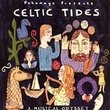| All Artists: Npr-Milestones of the Millenni Title: The Renaissance In Music (National Public Radio Milestones Of The Millennium) Members Wishing: 0 Total Copies: 0 Label: Sony Release Date: 1/12/1999 Genres: Special Interest, Pop, Classical Styles: Vocal Pop, Opera & Classical Vocal, Chamber Music, Forms & Genres, Ballads, Historical Periods, Early Music Number of Discs: 1 SwapaCD Credits: 1 UPC: 074646099223 |
Search - Npr-Milestones of the Millenni :: The Renaissance In Music (National Public Radio Milestones Of The Millennium)
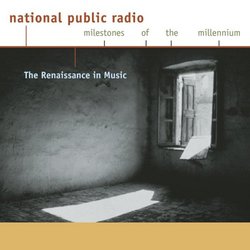 | Npr-Milestones of the Millenni The Renaissance In Music (National Public Radio Milestones Of The Millennium) Genres: Special Interest, Pop, Classical
Unlike some "greatest-hits" samplers, this well-chosen selection can serve a purpose for even some fairly advanced music lovers who still don't know this period well. Annotator David Fallows ties things together with perce... more » |
Larger Image |
CD DetailsSynopsis
Amazon.com Unlike some "greatest-hits" samplers, this well-chosen selection can serve a purpose for even some fairly advanced music lovers who still don't know this period well. Annotator David Fallows ties things together with perceptive commentary, and the performances chosen (most of them from stylistically enlightened recordings) are all quite fine. The uncredited programmer hasn't hesitated to emphasize great names (Dufay and Josquin Des Prez) or to include stylistically weird material (Solage's incredibly dissonant Fumeux fume). Only a few minutes after Solage, we get the gorgeous euphony of Tallis' Spem in alium! It's a pity that no texts are included, or that there isn't any bouncy dance music, but this is still a fine single-disc introduction to the period. The timing is about as long as possible. --Leslie Gerber Similarly Requested CDs
|
CD ReviewsRenaissance in Peace catherine guelph | milano, italy | 08/06/2000 (5 out of 5 stars) "I enjoyed this album of music from the Renaissance. Overall, it is a peaceful and comforting set of music. I found it something to listen to while I was reading or studying. This collection is diverse. It features works for voice both accompanied and cappela arrangements. There are also instrumental works for organ, as well as for lute. The liner notes are clear and informative. From them, I learned that Renassaince Music obtains its distinctive sound from gently flowing melodies, unpredictable phrase structures and an indirect approach to a tonal centre. These attributes made the music strange and yet captivating to me. If you are interested in music of the Renassaince Period or simply enjoy peaceful music performed well, this album will be interesting to you." An inexpensive portal into 14th-16th Century music Michael Schell | www.schellsburg.com | 04/09/2010 (4 out of 5 stars) "This is a pleasing sampler of early music recordings from the Sony vaults, put together by David Fallows, and mainly featuring performances by the Huelgas Ensemble (from the 1990s) and the Munich Capella Antiqua (from the 1970s). Although the album's title is The Renaissance in Music, the musical selections go back to Solage in the late 14th Century, considered medieval by almost anyone. His rondeau Fumeux Fume (Smokey Smoke) is famous to a generation of music history students that used a Norton textbook reprinting its score. It's also justly famous for its remarkable chromaticism, of the sort that wouldn't be approached again until the madrigals of Gesualdo and Marenzio in the late 16th Century). This is an oddly lugubrious performance, at a very slow tempo (taking over seven minutes) and with voices only. It seems incongruous given the humorous, perhaps sarcastic text (kind of a 14th Century "Smoke gets in your eyes"). There is an older, though more uptempo, rendition available in a set from the Early Music Consort of London that you might get as a contrast. A verelai by Matteo da Perugia, in a similarly chromatic vein, is coupled with Fumeux Fume. Even Dufay, working in the early 14th Century, isn't usually classified as a "Renaissance composer", since he still relied on Gothic cadences (with their characteristic double leading tone) and the curious "5-5 octave leap" cadence particular to his time period. Except for the cadences, though, his music does sound basically "Renaissancy". The Munich Capella Antiqua performs his famous ballad "Se la face ay pale", and three of his individual mass movements (a Kyrie, a Gloria and a Credo movement that aren't part of a complete mass setting). Too bad there are no excerpts from "Missa Se la face ay pale"! The German musicians double at least some of the vocal lines with instruments, a technique common when these recordings were made, but held in less favor by current scholarship. With Josquin, the most important composer of the early 16th Century, we are definitely in the realm of the musical Renaissance. Two of his motets are given by the Munich Capella Antiqua. Thomas Tallis is represented by his most famous work, the 40-voice motet "Spem in alium", rendered by the Huelgas Ensemble. This is as clear a recording of this piece as I've heard. Other 16th Century vocal pieces include madrigals by Festa and Verdelot, and an antiphon by Gombert. A couple of instrumental solos (organ and lute) round out this sampler. The presentation does cut some corners. My main gripe: no texts and no translations. And this in an album devoted mainly to vocal music, ugh. Still, the price is right, and the album certainly could have been far worse. The performances and recordings themselves are worthy, so if you don't already have the source recordings for this compilation, and you're interested in Western art music from this time period, then this set will certainly give you your money's worth." A good starting point for anyone interested in music of the Eddie Konczal | 05/15/2007 (4 out of 5 stars) ""The Renaissance In Music" is aptly named. It's not intended as a "best of," but rather an examination of major composers, trends, and genres that marked the Renaissance, here characterized as an era (1400 to 1600) in which vocal counterpoint reached new heights in elegance and sophistication. The cover picture of sunlight shining into a dark room is an evocative metaphor for the Renaissance itself, and for the CD's own effort to shine some light on long-darkened corners of music history.
The compilation establishes a strong focus on the 15th century by beginning with the works of Guillaume Dufay (1397-1474). Dufay excelled in both sacred and secular vocal compositions, as illustrated here by three Mass movements and the lovely chanson "Se la face ay pale." Pioneer of pervasive imitation Josquin Desprez (c. 1450-1521) is well represented with 20 minutes of music, the highlight being a stirring rendition of the virtuoso motet "Miserere mei, Deus" (not to be confused with the early 17th century Allegri work). Selections from the High Renaissance dispense with the usual suspects; notable omissions include Byrd, Lassus, Willaert & Palestrina. We hear a madrigal by Verdelot, a Marian antiphon by Gombert, and perhaps best of all, Thomas Tallis' magnificent 40-voice motet "Spem in alium." Instrumental pieces get rather short shrift, with only "Agincourt Carol" and a fantasia by Mudarra (c. 1510-1585) providing contrast to the stream of polyphony that dominates the CD. Some selections may induce head-scratching; for example, Solage's "Fumeux et fume." This bizarre, chromatic work represented the late Medieval "ars subtilior" style, an experimental movement that faded before the Renaissance began in earnest. A better selection from the transitional period from late Medieval to early Renaissance is Perugia's "Helas Avril," a three-part virelai which foreshadows Dufay's polyphony. Prominent Dufay scholar David Fallows provides insightful liner notes. The performances (which prominently feature the Huelgas Ensemble under the direction of Paul Van Nevel) are selected from a wide time frame (1965 to 1996), but fine mastering and clever sequencing makes the compilation flow nicely. "The Renaissance in Music," despite some notable omissions and curious inclusions, serves as a good starting point for anyone interested in music of the 15th and 16th centuries. The compilation's tantalizing selection should whet one's appetite for more music of the era. " |

 Track Listings (15) - Disc #1
Track Listings (15) - Disc #1